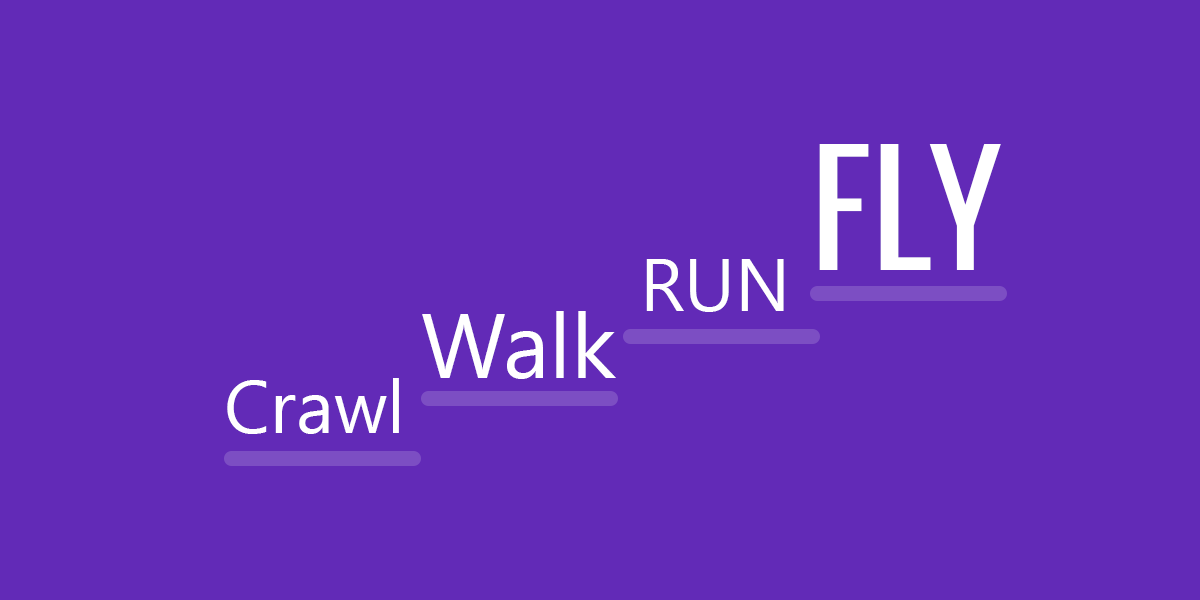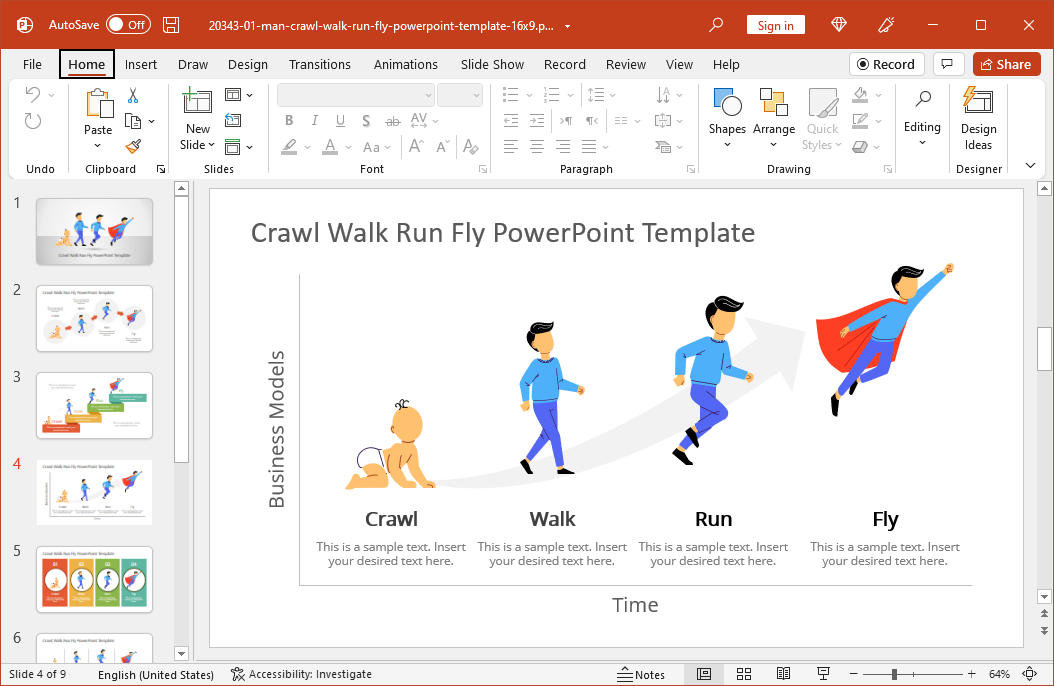Crawl, Walk, Run, Fly Approach for Business Success

Modern businesses strive to create a workforce that is client-centric, with employees that are motivated enough to get the job done successfully. Achieving such a feat isn’t as easy as it sounds. The Crawl, Walk, Run, Fly approach is a methodology that individuals in leadership roles use to try to achieve business success through a well-oriented workforce.
What is Crawl, Walk, Run, Fly Approach?
The Crawl, Walk, Run or the Crawl, Walk, Run, Fly approach is a methodology inspired by the words of Martin Luther King, Jr.
“If you can’t fly then run, if you can’t run then walk, if you can’t walk then crawl, but whatever you do you have to keep moving forward.”
The Crawl, Walk, Run, Fly methodology focuses on evolving a team to achieve something big using a phased approach, instead of trying to achieve it by making too many changes simultaneously. For this purpose, the first phase is to ‘crawl’ or to prioritize objectives and move forward by taking a small step towards a big goal. The next step is to ‘walk’ into the direction by making more concrete changes, followed by the ‘run’ phase which includes more comprehensive steps for creating workflows and implementing key measures to achieve the goal. Sometimes, another step, ‘fly’ is also added to the methodology, which implies completely embracing the change and reimagining your approach to achieve the desired goal.
The Crawl, Walk, Run, Fly approach starts off slow, and eventually picks up speed. This is why the initial phases of the approach require a slow-moving approach, which eventually results in making more rapid changes as you move along.
Key Components of the Crawl, Walk, Run, Fly Approach
1. Crawl
The Crawl phase in the Crawl, Walk, Run, Fly approach focuses on narrowing the focus to outline goals. During this phase, stakeholders can identify what improvements need to be made, what to work on, reduce deviation, etc. During this phase, you can create control and Pareto charts, set a roadmap, and even set up the groundwork for some of the goals.
Example: A furniture company has recently begun using e-commerce to also start selling furniture online. Previously, the business was only relying on sales from customers that walk into the company’s retail stores located in three different cities. For a better online presence, you are looking to implement a social media strategy to reach out to customers through popular social media platforms and optimize your website. Your company has lagged behind in adopting social media and digital technology for sales and currently has only a Facebook account that is rarely updated.
Using the Crawl phase, you might want to identify what is that you aim to achieve using social media (e.g. attracting a target audience, getting more leads, understanding the customer journey to map sales information via your website, etc).
In this example, during the crawling period, you can narrow your focus and identify a roadmap for the way ahead. You can create new social media accounts with company branding, start producing new content, and begin updating your company’s social media accounts more frequently. Similarly, you can put in place analytical tools to map the customer journey for your website and begin analyzing initial data.
2. Walk
The Walk phase is more complex, involving the implementation of different systems. This, for example, might include the incorporation of complex data collection sources and reporting tools employed to achieve desired results.
Example: Sticking to our example of the furniture business mentioned above, we assume that it has been a few months since the digital presence of the furniture company has been established, including a functional website and regularly updated social media accounts. You also have analytical tools and your teams in place to gather and interpret data, whereas your corporate culture now has incorporated your online presence to some degree, as your staff is now trained to tell customers about your online presence through business cards, flyers, inquiries on phone, etc. In other words, your corporate culture is now also adopting the digital presence.
In the Walk phase, the business can now begin analyzing the information acquired over the months to interpret sales data, customer preferences, customer journey through the company’s website, as well as determine what might be gaps that need to be filled and how sales can be improved.
3. Run
The Run phase is when the implementation of the gathered information is put in practice at a more extensive level. This might include planning to list specifications, extensive testing, adapting new techniques, constructing workflows and rules, etc.
Example: Based on the data analysis from previous months, your company has determined that customers are showing an increased interest in household furniture and the market for office furniture seems to be on a decline due to the COVID-19 pandemic, hybrid, and work from home initiatives. Furthermore, many customers seem to find it hard to use your online shopping cart because they include a sizeable amount (30%) of people who are not tech-savvy and require assistance in setting up their orders. Another significant finding has been the need to facilitate potential clients by answering them with relevant suggestions. You are also engaging social media influencers and bloggers to improve the digital presence of your business.
In the Run phase, the company will implement methods by which you can capitalize on potential leads by facilitating less tech-savvy clients through on-call orders. In this case, the agent will set up the order on call and through orders received via Facebook, WhatsApp, Instagram, etc. Your sales team is now equipped and have their assigned tasks to aim to facilitate clients in setting up their orders on-call, as well as to provide different options to people seeking suggestions via social media accounts, messaging apps, website chat, and email.
4. Fly
The Fly phase includes fully embracing the change to achieve desired goals. Your workforce should be in sync with the changes and must now be able to use the new workflows and systems regularly.
Example: In the example of the furniture company, we can assume that during the Fly phase, the company was able to fully adopt digital technology to sell furniture online. Not only are the new workflows and systems in place but the workforce is fully equipped to cater to customer needs using digital technology through digital catalogs, sales agents, an optimized website, and social media accounts with thousands of active followers. Furthermore, influencers and bloggers have now begun visiting your store and giving out reviews, leading to an increase in leads and sales.
The Fly phase is the most rapid phase, where aspects like resistance to change and problems in the adoption of new systems should have been overcome. If implemented correctly, this phase can help produce rapid results for a business.
Crawl, Walk, Run, Fly PowerPoint Template
To orient your team regarding the Crawl, Walk, Run, Fly approach or to make a presentation regarding the concept you can use the Crawl, Walk, Run, Fly PowerPoint Template. With editable slides and attractive illustrations, the template outlines all four stages of the methodology. The slides come with different illustrations highlighting each phase of the approach with placeholders set in a manner that is easy for presenters to create and present the concept. You can download this Crawl Walk Run Fly PowerPoint template for presentations in PowerPoint or Google Slides.

Final Words
Like any methodology, the Crawl, Walk, Run, Fly approach is not without limitations. Sometimes, a business can crawl for too long or fly past important developments in the wrong direction. Not understanding customer needs accurately or rushing through steps without careful consideration can result in the failure to implement the approach according to its true spirit.
While there are also many critics of the approach, it is largely regarded as a successful way to implement change and achieve business goals through a phased approach. The methodology itself teaches businesses to not rush the implementation of new systems for quick success, as you cannot begin to walk without crawling first or learn to run at full speed without walking. And if you get things right, you can fly your way to new horizons.
